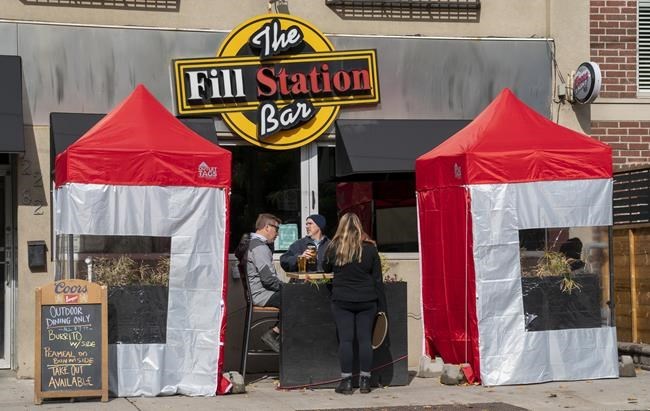TORONTO — Erin Gamelin started scouring the internet for a cost-effective version of the outdoor dining pods she’d seen photos of online when stricter public health measures shut down indoor dining in Ontario's COVID-19 hot spots this month.
She settled on mini greenhouses that fit perfectly over a table for two on the patio of her Toronto establishment and ordered 10 for $1,000. The eye-catching tables, that come with a complimentary blanket, have been a hit with customers at Louis Cifer Brew Works.
But Gamelin is skeptical the makeshift pods, or her business, will make it through an Ontario winter if indoor restaurant dining remains banned in the city after Nov. 7.
“It remains to be seen if these can survive the snow and the elements,” Gamelin said. “I don’t really want to test that theory.”
Some temporary patios that popped up in Toronto curb lanes during the summer will have to come down for snow clearing, but city council is considering allowing others on sidewalks and parking lots to stay open through the winter.
Restaurant operators, however, are doubtful that a government-sanctioned winter patio season will guarantee success.
“It’ll be up to the consumer and the weather to decide if they're going to extend patio season,” Gamelin said.
Indoor dining at bars and restaurants was banned province-wide when the pandemic hit in the spring, and is currently prohibited once more in the four COVID-19 hotspots of Toronto, Peel Region, York Region and Ottawa.
James Rilett, vice-president with industry group Restaurants Canada, said operators are struggling with debt accrued since the first shutdown and many are not able to take the financial risk of investing in available solutions like patio heaters and weather protection.
There’s also confusion in the sector over municipal guidelines for COVID-safe outdoor dining, such as requirements for natural ventilation in tents that could make heaters inefficient, Rilett said.
“They’re wanting to do it right but they're also going to want to do something that'll be successful,” Rilett said. “No matter how good the heater is, if the wind’s blowing down your back, it's going to be hard to be comfortable.”
Ottawa restaurant owner Tony Canonico said he’s frustrated there was no warning from the government before the second shutdown.
He had already dismantled the patio at Mezzonotte Italian restaurant when the indoor dining closure was announced, and he estimates it cost close to $4,200 to reinstall it.
Canonico said he understands the importance of the regulations but people in the sector like himself feel unfairly targeted after complying with the rules all summer.
“We've done it to save lives. But it’s growing very tiresome,” Canonico said.
There’s also the question of at what point an outdoor dining tent becomes an indoor space, making safety precautions moot.
Municipalities have generally asked for two sides of dining tents to remain open.
Dr. Susy Hota, medical director of infection prevention and control at Toronto’s University Health Network, said it’s a fine line that depends on how much air is flowing through the structure, but exposure to the elements might make it challenging to operate a dining room.
She said with all precautions in place, outdoor dining doesn’t pose a greater risk than have a socially distanced visit with a friend outdoors.
But it’s easy to slip up in a restaurant setting where people are inclined to speak loudly, sit close together, not wear masks and share food, which increases the risk of transmission, she said.
It’s also an industry where spaces aren’t uniform across the board, making targeted restrictions on indoor dining particularly complicated, she said.
“It’s a tough one,” Hota said. “Not every restaurant is designed the same way and not all are in the same types of building and they have variable practices.”
Domenic Santaguida said he plans to fight the $880 fine handed to his Ottawa restaurant last week for not having enough patio tent panels open.
He said the business has opened some panels on the tent at Vittoria Trattoria, but he argues it would be impossible to run a restaurant with a half-open tent in the fall and winter, especially at his location near the Ottawa river.
"We've had to chase stuff down the street in the middle of summer with the wind," he said. "It's not realistic at all."
This report by The Canadian Press was first published Oct. 21, 2020.
Holly McKenzie-Sutter, The Canadian Press



